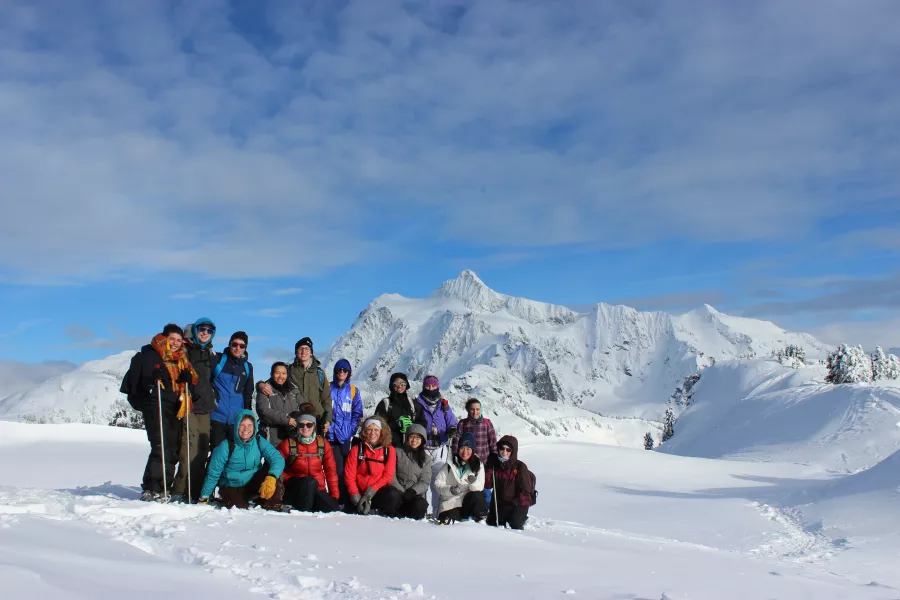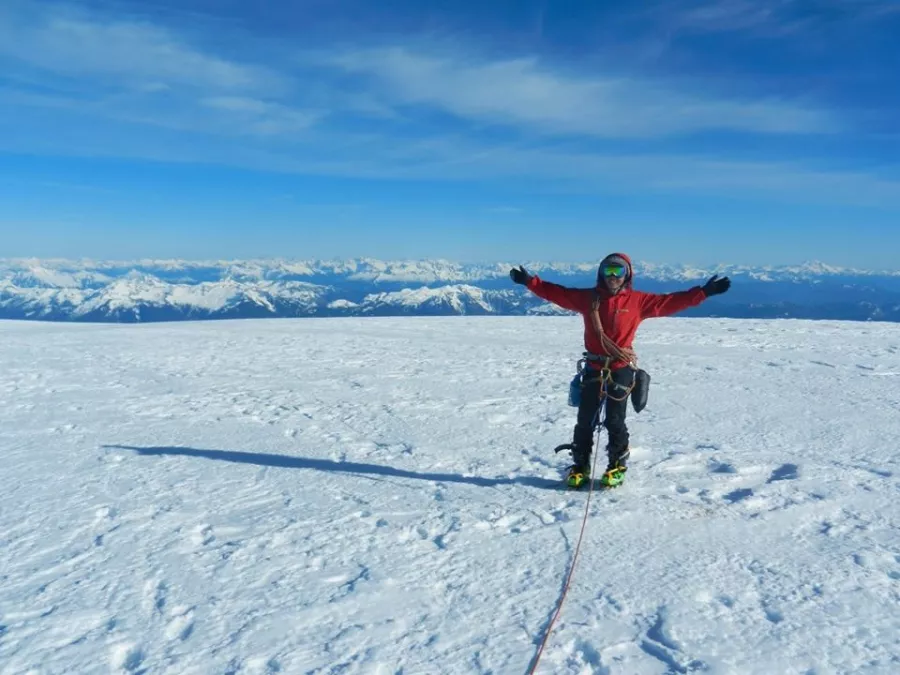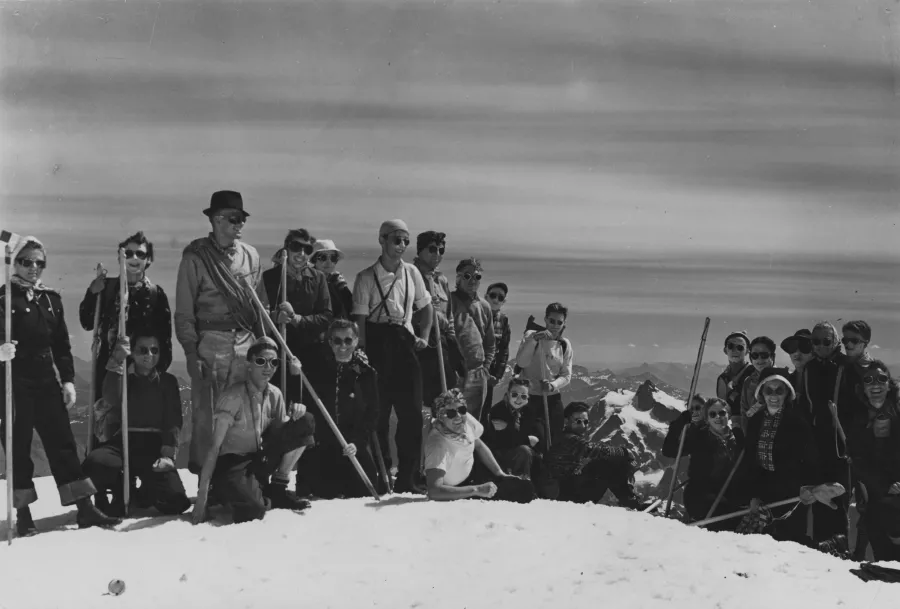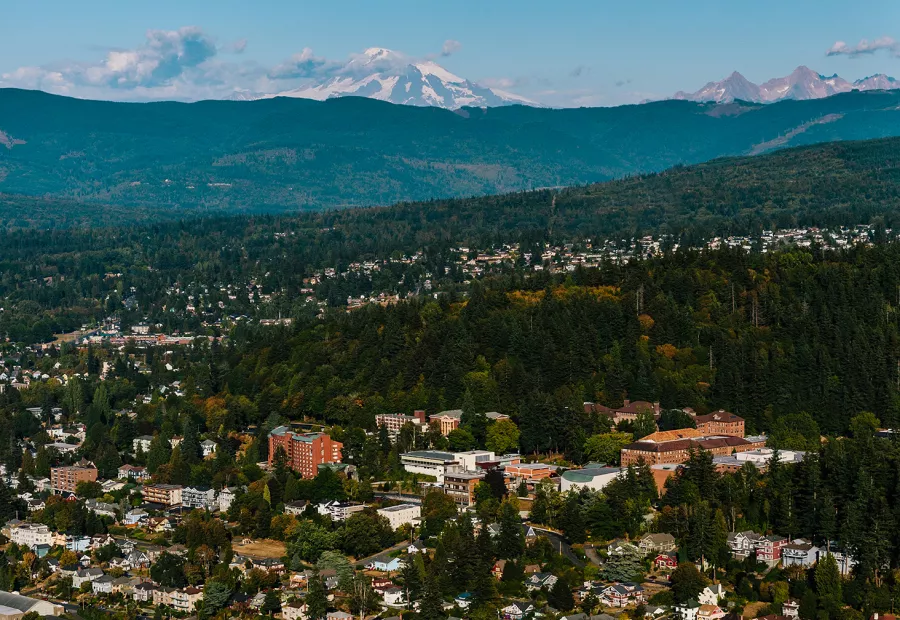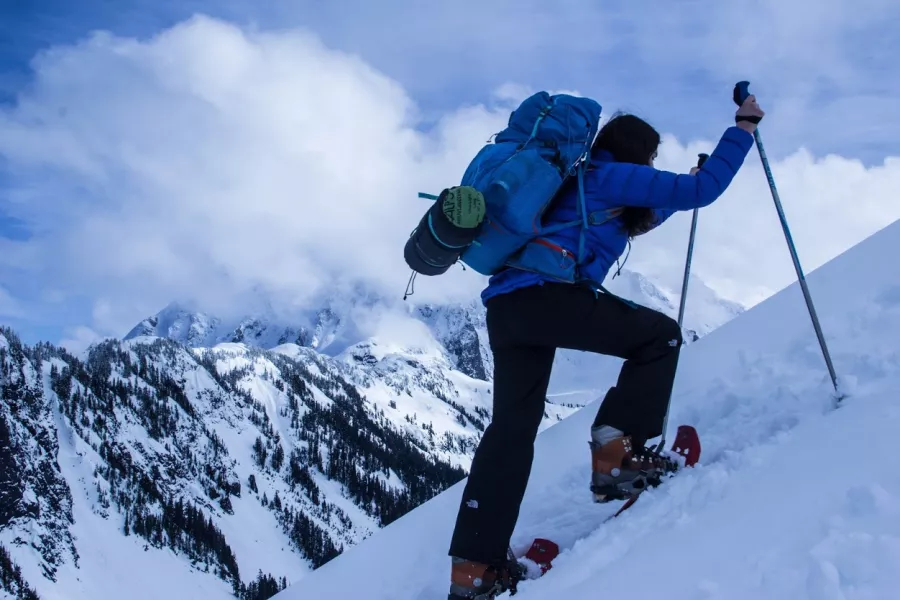Unless you have a hot air balloon or helicopter at your disposal, it’s not even visible from campus. But the icy crown of Mount Baker occupies an unusually warm spot in the heart of Western Washington University.
Always has.
This is a love affair with serious staying power: Almost from the day it opened in 1899, many of the students, staff and faculty composing the Western community have kept one eye on the business at hand—education—and another longingly on the snow-crested, 10,781-foot landmark looming about 60 miles to the east, on the windward edge of the North Cascades mountain range.
The Mount Baker Wilderness, its biggest campus boosters say, is more than just a subject of research and a frequent recreational getaway for hikers, cyclists, backpackers, skiers and snowboarders, and budding mountaineers. It has become part of the very identity of the university—a rock-and-ice monument to the green-focused Northwest outdoor spirit that lures students and educators from around the globe to Washington’s “Fourth Corner.”
The mountain, even represented in the abstract in Western’s official logo, is central to the university’s rep as a top destination for students and faculty members who value outdoor recreation, Western admissions officials say.
But its impact extends beyond mere fun. The fitfully sleeping stratovolcano, coupled with the saltwater lying even closer to campus, also provides the university with a living-laboratory research spectrum that few universities can match, says John C. Miles, professor emeritus of Huxley College and the author of “Koma Kulshan: The Story of Mt. Baker.”
“We used to say that if you went to Western and you wanted to study different natural environments, you could do it all the way from the bottom of Puget Sound to the glaciers of Mount Baker,” explains Miles, dean of Huxley from 1985 to 1992. “We played that up, emphasizing all the opportunities.”
As part of a campaign to rebuild Huxley’s base of environmental studies majors after a downturn in the Reagan era of the mid-1980s, the college placed a stunning telephoto shot of the mountain on Huxley brochures and mailed them around the country.
“That use of Baker as the attraction ... it worked!” Miles recalls. “I think people just say: ‘Wow. We want to go out there!’”
Classroom on the mountain
Then, like now, Western’s faculty seized the opportunity to make use of the unique alpine environment of Mount Baker, the nearby 9,131-foot Mount Shuksan and surrounding North Cascades peaks as a living laboratory—a rugged, undeveloped wilderness providing rare opportunities for the study of geology, glaciology, forestry, biology and other disciplines. That trend has escalated in recent years, with many traditional fields of study sharing space in the alpine zone with newer, student-led interdisciplinary programs.
Even the mountain’s longstanding primal draw—the urge to get up on it and climb, hike or ski—has taken on an academic bent of late, with a new slate of “experiential education” programs. These programs provide an outdoor education to new students as well as leadership training for their older peers— while simultaneously building the sense of extracurricular “community” proven to increase university student retention rates, and even help students succeed academically.
That’s the next big step in Western’s long-term love affair with its natural surroundings, says Stephen Magnuson (’13, B.A., recreation), program coordinator of WWU’s Outdoor Center, which offers equipment rental, training and guided excursions to students.
Western’s Outdoor Orientation Training (WOOT) trips for incoming students were launched in 2010 as a graduate student experiment and now are gaining a reputation as a don’tmiss experience for the outdoors-inclined student—or even those who just want to dip a tentative toe into those mountain streams. Students who embark on the week-long backpacking or sea kayaking treks immediately before starting classes at Western say the program plants a seed that blooms throughout their entire college career and beyond.
The program has grown to offer almost two-dozen annual trips, now accommodating more than 200 students a year.
It’s simply taking advantage of what lies immediately next to Western’s Bellingham campus. Students embarking on similar adventures at many universities spend much of their time offcampus commuting to and from the wilderness, Magnuson says. “Ours get to do it in their own backyard.”
Data compiled by Western’s program and others show WOOT participants, much like students in other WWU “firstyear experience” programs, tend to fare better academically while building peer-group communities—all factors in a sense of “belonging” that contributes to student retention. The week-long trips, of course, are also just great fun, even for the inexperienced.
“Students want it,” Magnuson notes. “There’s incredible demand for it now.”
Fortunately for Western, the Baker region and the surrounding alpine environment are proven magnets for the students who wind up leading those excursions. Students seeking careers in outdoor leadership often arrive on campus with an unusually high degree of mountaineering skill.
“Some of our students come here with a high level of technical ability,” Magnuson says. “They’re coming here because they want to ski or climb.”
What’s most rewarding for Outdoor Center trip leaders, he adds, is seeing that spark of passion among students exposed to the otherworldly views and natural environments of the Baker area for the first time—and watching the confidence they build in the backcountry transfer into success in other areas.
These days students aren’t waiting to share their love for the mountain with their same-age peers. Students in Western’s Outdoor Recreation degree program now lead half-day “Snow School” sessions for younger students.
The idea grew from similar fifth-grade Mountain School sessions offered at Diablo Lake by the Western-affiliated North Cascades Institute. Snow School, offered in a partnership with Mt. Baker Ski Area, aims to instill a sense of respect for the local alpine world at a young age. Students are bused to the mountain, equipped with snowshoes for a hike, and take an avalanche course conducted by the Northwest Avalanche Center.
“We’re kind of teaching the students about general weather observations, temperature, what’s going on in the sky,” says Boulder, Colorado, native Alex Martin, a 2017 Western graduate in recreation and Snow School instructor. “The whole focus of the activities is to demonstrate where the Mount Baker watershed begins—where all that water starts, and the importance of it all to the environment.”
The Baker Bug
The truth, of course, is that student leaders also love leading treks onto the sturdy shoulders of Mount Baker because they long ago caught the Baker Bug themselves and are looking for any excuse to get back to the sweet-smelling alpine air looming above the Nooksack River drainage.
For some, it becomes an obsession.
Consider the recent exploits of Tatsu Ota, a native of Japan who grew up on Seattle’s Eastside and arrived at Western having no idea he was about to fall in love with a glaciated peak. His first trip to the mountain, in 2014, was a climb with friends. They made it to the summit, but it wasn’t smooth sailing for Ota, who admits, “I had no idea what I was doing.”
He immersed himself in Western’s mountaineering offerings and honed new skills for his next encounters. Ota was a swift study. He hooked up with friends to climb the mountain again, making several ski descents.
As a sophomore, he helped guide a summit trip for the Outdoor Center, working as an assistant instructor for the program’s spring mountaineering course.
“By that time, I had climbed Baker three times, skiing off of it each time. One time I skied off of it naked. Well, I was wearing a Washington flag as a cape, but nothing more.”
Just to satisfy the curious: Ota did so because, well, it feels “surprisingly good,” with the wind blowing through your ... hair, he says. Just don’t fall.
The Environmental Science major spent many more months skiing the Baker/Shuksan backcountry, gaining skills and confidence in a rugged, avalanche-prone alpine world. Before long, he and a couple friends began dreaming of their own human-powered, bay-to-summit expedition, inspired somewhat by accounts of early “Mount Baker Marathon” adventurers who beginning in 1911 raced from Bellingham to the summit and back, using trains, automobiles and any means available. (The mountain marathon, the inspiration for the modern Ski to Sea race, was short-lived, canceled in 1914 after too many near-death experiences.)
Ota and two friends devised a plan to bicycle from Bellingham Bay to a trailhead above Glacier, climb to the summit, ski back down, then cycle back to the bay. In May 2016, they pulled it off on their first attempt, heading out of Bellingham at midnight on bikes with skis attached.
“We biked all the way up to the trailhead, hiked up to snow, and started skiing up,” Ota says. “It was very exhausting. So exhausting that we started falling asleep as we’re walking, having weird hallucinations. By some luck, we made it to the summit and skied down.”
The trip, culminated by dipping of bike tires back in Bellingham Bay, took 30 hours.
“We slept for two hours, then went to work,” he recalls. “I guess Mount Baker does hold a close spot in my heart.”
Love turned cold
That intense addiction to the thin air of Baker and its craggy neighbors has been a bug at Western for nearly a century. And at various times throughout the institution’s history, the mountain’s rugged, potentially dangerous nature has been driven home in heart-rending ways. Baker has provided generations of thrills for Western’s family members, but also has claimed a number of lives in the process.
The most tragic events unfolded in the early summer of 1939—by coincidence, during the final weeks on campus of longstanding university President Charles H. Fisher, who had already been formally relieved of his job, effective at the end of the summer session, by the college board of trustees after being falsely accused of communist leanings.
Fisher, an East Coast native, had his own longstanding love affair with Mount Baker. Given that, he was personally devastated when a freak avalanche below the “Roman Wall” on Baker’s Coleman Glacier summit route on July 22, 1939, swept a large group of climbers—mostly Western students, faculty and acquaintances—off the mountain, some into a gaping crevasse. Six died and four were never recovered. It was the worst mountaineering disaster in U.S. history.
The tragedy didn’t stop the annual summit climbs by Western students and faculty, however. Some of those involved in the 1939 incident returned to the summit in subsequent years. The avalanche is memorialized to this day by a littleknown campus monument at the north end of Old Main.
While the ’39 accident remains a notably dark mark on Western’s history, it was not the only fatal encounter between students and the alpine area around Baker’s slopes. Most recently, a trio of Western students setting out to celebrate the end of winter quarter with a snowshoe trek to Artist Point were buried in an avalanche below Table Mountain in December 2003. One of the students, J.P. Eckstrom of Shoreline, died in the accident. The other two miraculously survived after being buried in the snow overnight.
One family with a connection to the dangers of Mount Baker is also intimately familiar with the glories it offers. Duncan Howat (’63), general manager of Mount Baker Ski Area since 1968, thinks about this dichotomy often. Howat’s uncle, Maynard, and his fiancée, Hope Weitman of Chewelah, both 23, died in the 1939 avalanche and remain entombed in Coleman Glacier. Howat’s father helped build the campus memorial to the fallen.
But Duncan Howat also is intimately familiar with the sort of inspiration the mountain brought—and continues to bring—to the community of Western and other mountainloving constituencies far beyond. In a decidedly wild location with no commercial signs nor electricity, except what’s produced by generators to power lifts and lodges, Howat’s ski haunt was one of the first in North America to allow snowboarders to ride chairlifts, just like “regular” skiers.
The ski area, located mostly on the shoulders of Mount Shuksan, not Mount Baker itself, quickly became globally famous as a slice of snowboarding and backcountry skiing heaven. It remains so, drawing dozens of the world’s top riders each winter to a celebrated race, the Mount Baker Legendary Banked Slalom, in a natural creek bed on the mountainside. Racers enter beneath a gate in front of a handcarved sign with the admonition: “Say your prayers.” The winner is awarded a grand trophy fashioned from a roll of duct tape.
That’s the sort of raw, human-and-nature connection the mountain has always fostered—and the same one appreciated and revered by generations of Western’s extended family.
It is why a long running joke about some Western students—“She went to Bellingham to study accounting, but wound up majoring in snowboarding”—really isn’t a joke at all, in some cases. And why the lessons learned from those fresh-air days in the sweeping North Cascades alpine make that a worthy life goal in its own right.
If a century of exploration on Mount Baker has taught anything to the university that has embraced the icy peak, it is that lessons learned on the high alpine vistas of the North Cascades have lifelong value that transcends classroom-style learning.
“The outdoors is the biggest metaphor for life,” says the Outdoor Center’s Magnuson. “It’s all transferable.”
Even as he speaks, students are signing up for open slots— and a waiting list—for the 2017 student-led Memorial Day trek to the summit.
“The mountains are calling,” the trip description reads, “and we must go!”
Mount Baker: A Backyard Alpine Wonderland
“Wild” in every sense:
The Heather Meadows area is surely one of the wildest spots one can reach in the Northwest via a paved road. (It is the sort of alpine destination one might hike for a solid day to reach in other parts of the Cascade Range.) The area is so wild that people can get in trouble here in winter a few dozen feet from their car. An early movie version of the Jack London classic "The Call of the Wild" was filmed here in 1934, largely because the terrain was seen as a passable stand-in for remote Alaska.
Does it snow a lot?
Uh, yeah. Mount Baker Ski Area averages more than 650 inches of accumulated snowfall annually. In the winter of 1998-99, the ski area obliterated Mount Rainier's single-season record for snowfall, amassing 1,140 inches, or 95 feet—a world record for a one-season snowfall.
Peak bagging:
The first recorded successful climb of Mount Baker was made on a third attempt by Edmund Thomas Coleman, an Englishman living in Victoria, B.C. in August 1868, via the Middle Fork Nooksack, Marmot Ridge, Coleman Glacier, and the northern Roman Wall.
Where’s the summit?
It’s not a simple question. Mount Baker has two summit cones – Sherman and Carmelo craters, buried below its icy crown. Carmelo, the oldest, hosts the high point. Hundreds of fumaroles continue to frequently vent gases from around the summit; lahars created by heat from Sherman crater flowed down the mountain in the 1840s.
Once A Volcano, Always...
In technical terms, Mount Baker is a “glaciated andesitic stratovolcano.” That means that yes, it likely will erupt again sometime. Baker, which sits atop a much-older volcanic cone known as Black Buttes, is the second most-active volcano (behind only Mount St. Helens) in the Cascade Range. It is second only to Mount Rainier in terms of glaciation, although like other Cascade Peaks, Baker’s glaciers have been shrinking in recent years due to warming temperatures. The last lava flow from the summit was about 10,000 years ago, but an eruption of ash occurred about 6,600 years ago. The most-recent volcanic activity of concern from the peak—a venting of steam and some sliding— occurred in 1975.
— Ron C. Judd

